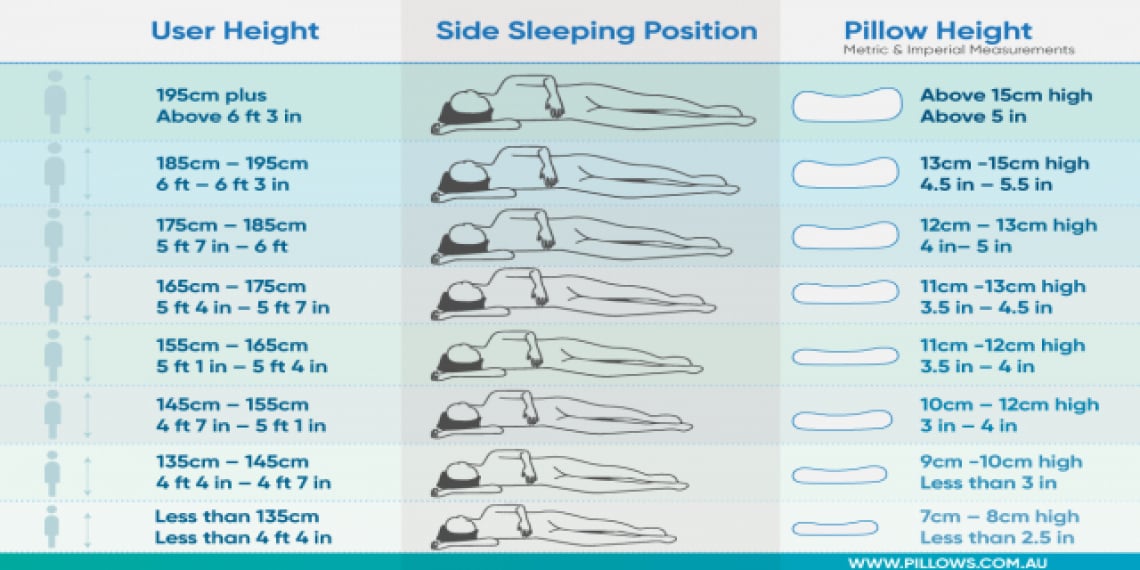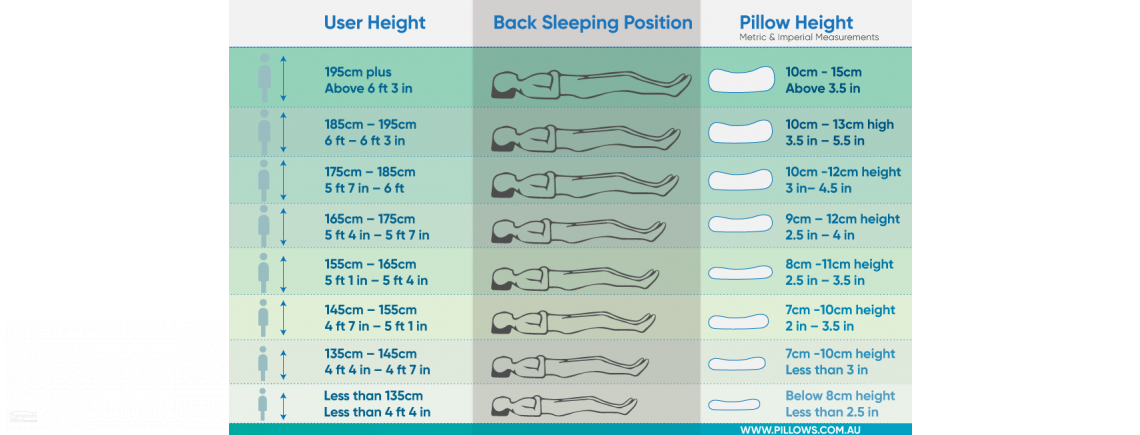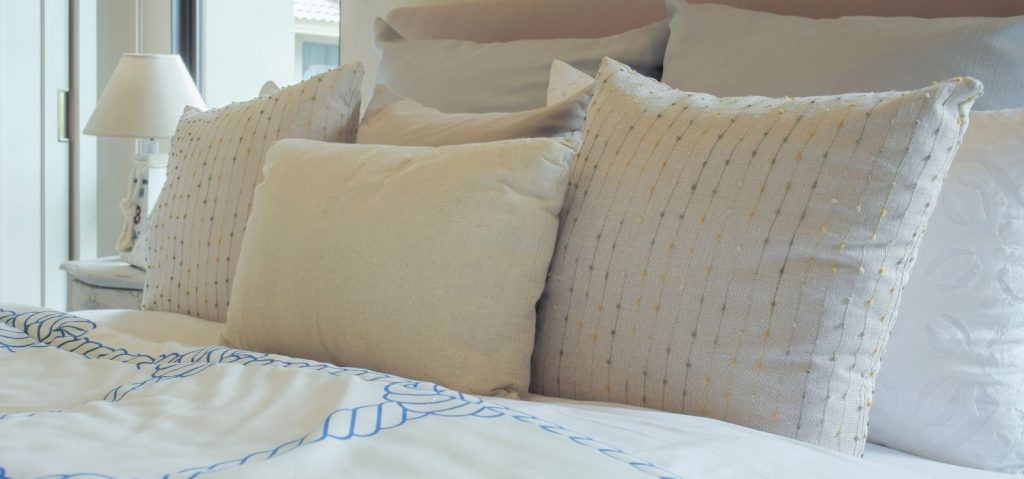The most important thing to remember when choosing the correct pillow is to maintain correct sleeping alignment.
When lying on your side or on your back you want to maintain a straight back and spine without any pressure on your neck or muscles.
Have a health professional check your alignment with your pillow to make sure it provides the support that you need.
Common Pillow Sizes
| Pillow size: | Metric Measurements (cm) | Imperial Measurements |
|---|---|---|
| Standard | (51 x 66 cm) | 20" x 26" |
| Queen | (51 x 76 cm) | 20" x 30" |
| King | (51 x 92 cm) | 20" x 36" |
| European square | (66 x 66 cm) | 26" x 26" |
Common Decorative Pillow Sizes
| Type: | Metric Measurements (cm) | Imperial Measurements |
|---|---|---|
| Typical Boudoir/Breakfast Pillow | (30 x 41 cm) | 12" x 16" |
| Typical Square Throw Pillow: | (46 x 46 cm) | 18" x 18" |
| Typical Neckroll Pillow: | (15 x 33 cm) | 6" x 13" |
Choosing the right size pillow is a key ingredient in making sure you get the best possible night’s sleep. A poor pillow choice can lead to back, neck and shoulder problems and may leave you restless and tired for the day ahead.
Recommended Pillow Heights Based on Your Height
Side Sleeper
| Users Height Metric (cm): | Pillow Size Metric Measurements (cm) | User Height Imperial (inches) | Pillow Height Imperial (inches) |
|---|---|---|---|
| Less than 135cm | 7cm – 8cm high | Less than 4 feet 4 inches | User Height Metric (cm): |
| 135cm – 145cm | 9cm -10cm high | 4 feet 4 inches – four feet 7 inches | Less than 3 inches |
| 145cm – 155cm | 10cm – 12cm high | 4 feet 7 inches – 5 feet 1 inch | 3 inches – 4 inches |
| 155cm – 165cm | 11cm -12cm high | 5 feet 1 inch – 5 feet 4 inches | 3.5 inches – 4 inches |
| 165cm – 175cm | 11cm -13cm high | 5 feet 4 inches – 5 foot 7 inches | 3.5 inches – 4.5 inches |
| 175cm – 185cm | 12cm – 13cm high | 5 foot 7 inches – 6 foot | 4 inches – 5 inches |
| 185cm – 195cm | 13cm -15cm high | 6 foot – 6 foot 3 inches | 4.5 inches – 5.5 inches |
| 195cm plus | Above 15cm high | Above 6 foot 3 inches | Above 5 inches |
Back Sleeper
| Users Height Metric (cm): | Pillow Size Metric Measurements (cm) | User Height Imperial (inches) | Pillow Height Imperial (inches) |
|---|---|---|---|
| Less than 135cm | Below 8cm height | Less than 4 feet 4 inches | Less than 2.5 inches |
| 135cm – 145cm | 7cm -10cm height | 4 feet 4 inches – four feet 7 inches | Less than 3 inches |
| 145cm – 155cm | 7cm -10cm height | 4 feet 7 inches – 5 feet 1 inch | 2 inches – 3.5 inches |
| 155cm – 165cm | 8cm -11cm height | 5 feet 1 inch – 5 feet 4 inches | 2.5 inches – 3.5 inches |
| 165cm – 175cm | 9cm – 12cm height | 5 feet 4 inches – 5 foot 7 inches | 2.5 inches – 4 inches |
| 175cm – 185cm | 10cm -12cm height | 5 foot 7 inches – 6 foot | 3 inches – 4.5 inches |
| 185cm – 195cm | 10cm – 13cm height | 6 foot – 6 foot 3 inches | 3.5 inches – 5 inches |
| 195cm plus | 10cm - 15cm | Above 6 foot 3 inches | Above 3.5 inches |
The most important thing above all is to maintain correct sleeping alignment. When lying on your side or on your back you want to maintain a straight back and spine without any pressure on your neck or muscles. Have a friend, partner or better yet your health professional have a look at your alignment with your pillow to make sure that the pillow provides the support that you need.
Position you to sleep
The biggest factor in deciding the size and shape of the pillow you choose is the position in which you sleep. Generally, if on your side which is the most recommended the gap between your head and the mattress should be filled so that your neck, head and spine are all in alignment. Generally, a side sleeping pillow should have a firm to medium feel so that it gives you the support that you need.
If you’re a back sleeper you need a pillow that will just give a little bit of support under the back of the neck and ensure that the head does not tilt too far forward. A softer pillow should suffice. If sleeping on your stomach, then you really don't need much of a pillow at all Low and soft is the best but you.
How often should I change my pillow?
We would suggest approximately every 2-5 years depending on the quality of the pillow. Also definitely use a pillow protector with your product. This will stop it from being affected by sweat, moisture and bacteria which are far and away the most common causes of pillow degradation.
With so many pillows out there it is difficult to choose the right one but here is a broad chart that we thought you might find helpful to choose the right pillow. We have based our testing on a medium firmness bed. If you have a softer bed then you can look at getting a slightly lower pillow than what has been described below as you will be sinking in a little bit further.
Position your sleep.
A quick pillow test for correct head and neck support
1) Stand against or next to a wall in the same style you would lie on your mattress. Either side against the wall, back against the wall or tummy against the wall.
2) Place your head against the wall and you will notice a gap between your head and the wall. This is the gap that your pillow is required to fill.
3) Now place the pillow between the wall and your head and check the alignment of your spine. Is it straight or is it curved, and would you think you would be happy to spend the night in this position?
The pillow that is the one for you will have you looking straight ahead with a straight neck. This will allow your spine, neck and head to be fully supported throughout the night.
Pillow Selector
Here is some helpful information when looking at buying a pillow and should give you a good start in the right direction.
Pillow Sizes for Side Sleeping Position

Pillow Sizes for Back Sleeping Position

How often should I change my pillow?
We suggest every 2-5 years depending on the quality of the pillow. We would also suggest using a pillow protector as this provides extra care and hygiene and assists in preventing sweat, moisture and bacteria from making their way into the pillow which is the most common cause of pillow degradation. With so many pillows out there, it is difficult to choose the right one for you. Please look at our charts provided to find the correct, most comfortable one for you. We have based our testing on a medium firmness bed. If you have a softer bed, then look at getting a slightly lower pillow than described.
Pillow Selector
Here is some helpful information when looking at buying a pillow and should give you a good start in the right direction.
Do you want to learn more? Read our Frequently Asked Questions for...
Contour pillows, also known as contoured pillows, are designed to provide better support and alignment for your head, neck, and shoulders while you sleep. These pillows are shaped with curves and contours that follow the natural curves of your body, allowing for a more comfortable and personalized sleeping experience.
The unique design of contour pillows offers several benefits. Firstly, they help to alleviate neck and shoulder pain by promoting proper spinal alignment. The contoured shape cradles your head and neck, reducing pressure points and ensuring that your spine remains in a neutral position throughout the night. Secondly, contour pillows can improve your overall sleep quality. By providing optimal support, they help to reduce tossing and turning, allowing you to enjoy a more restful and uninterrupted sleep.
Contour pillows, or contoured pillows, are indeed better for those seeking improved comfort and support during sleep. Their unique shape and design promote proper spinal alignment, alleviate neck and shoulder pain, and enhance overall sleep quality. If you are looking for a pillow that can provide personalized support and help you wake up feeling refreshed, a contour pillow may be the ideal choice for you.
 0
0 1
1Contour pillows are designed to provide better support and alignment for your head, neck, and shoulders while you sleep. Unlike traditional pillows, contour pillows have a unique shape that follows the natural curves of your body. This helps to reduce pressure points and promote proper spinal alignment, resulting in a more comfortable and restful sleep. The contoured design of these pillows can also help alleviate neck and shoulder pain, as well as reduce snoring and sleep apnea symptoms. Overall, contour pillows offer a more personalized and supportive sleep experience, making them a popular choice for those seeking improved comfort and sleep quality.
 0
0 0
0Contour pillows can be beneficial for individuals experiencing neck pain. These pillows are specifically designed to provide support and alignment to the neck and head, which can help alleviate discomfort. The unique shape of contour pillows helps to cradle the neck and promote proper spinal alignment, reducing strain on the neck muscles. By providing adequate support, contour pillows can help relieve tension and pressure, allowing the neck muscles to relax and recover during sleep. Many people find that using a contour pillow can improve their sleep quality and reduce neck pain, making it a suitable option for those seeking relief.
Contour pillows are designed to support the neck and promote proper spinal alignment, making them a good choice for individuals experiencing neck pain. These pillows can help alleviate discomfort by cradling the neck and reducing strain on the neck muscles. By providing adequate support, contour pillows can improve sleep quality and allow the neck muscles to relax and recover. If you suffer from neck pain, using a contour pillow may be worth considering to help alleviate your symptoms and improve your overall sleep experience.
 0
0 0
0Yes, contour pillows can be beneficial for side sleepers. These pillows are specifically designed to provide support and alignment to the head, neck, and shoulders, which is crucial for maintaining a proper sleeping posture. The unique shape of contour pillows, with a dip in the middle and raised edges, helps cradle the head and neck, promoting spinal alignment and reducing pressure points. This can alleviate discomfort and prevent the development of aches or stiffness that side sleepers may experience. By offering personalized support, contour pillows can enhance the quality of sleep for side sleepers, allowing them to wake up feeling refreshed and rejuvenated.
 1
1 0
0Yes, firm pillows can be beneficial for neck pain. When you sleep on a firm pillow, it provides better support to your neck and helps maintain proper alignment with your spine. This can alleviate strain on your neck muscles and reduce discomfort. Firm pillows are especially recommended for individuals who sleep on their back or side, as they help keep the head and neck in a neutral position throughout the night. However, it's important to note that the ideal pillow firmness may vary from person to person, so it's essential to find the right balance of support and comfort that works best for you.
 1
1 0
0








